
All images © by Roberto Piperno, owner of the domain. Write to romapip@quipo.it.
Notes:
Page revised in August 2021.

All images © by Roberto Piperno, owner of the domain. Write to romapip@quipo.it.
Notes:
Page revised in August 2021.
 - Orange
- OrangeYou may wish to see an introductory page to this section first.
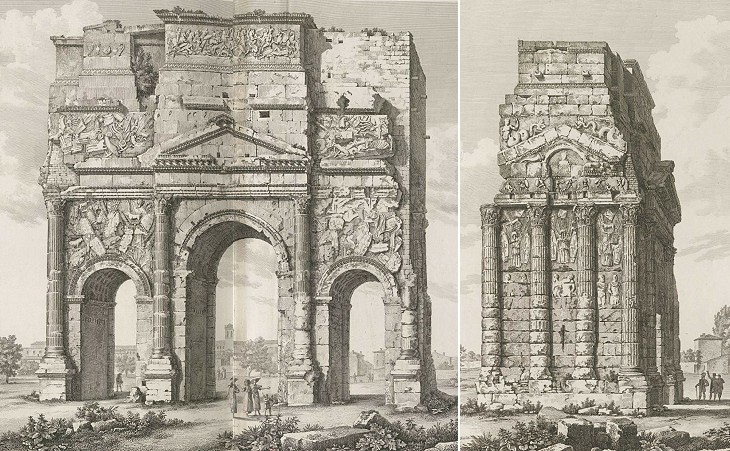
Triumphal Arch in two plates from "Alexandre de Laborde - The Monuments of France Chronologically Classified - 1816-1836": (left) northern side; (right) eastern side
Orange, the Arausio of the Romans, is still distinguished by some noble monuments of antiquity. These consist of a circus, an aqueduct, a temple, and a triumphal arch. (..) It is a very magnificent edifice, adorned on all sides with trophies and battles in basso relievo. The ornaments of the architecture, and the sculpture, are wonderfully elegant for the time in which it was erected; and the whole is surprisingly well preserved, considering its great antiquity. It seems to me to be as entire and perfect as the arch of Septimius Severus at Rome.
Tobias Smollett - Travels through France and Italy - 1766
Smollett visited Orange on his return trip from Italy, but English travellers on their way to that country were apprised by William Coxe in the 1819 Galignani's Traveller's Guide Through France:
In the neighbourhood of Orange (..) an inhabitant of northern climes will here behold the face of the country totally different from what he had been accustomed to see. Corn fields, vineyards and numberless mulberry trees diversify the enchanting prospect: here are also to be seen some olive and pomegranate trees. We are now on truly classic ground and the farther we proceed the more numerous and interesting are those monuments of antiquity which the Romans left in this country.
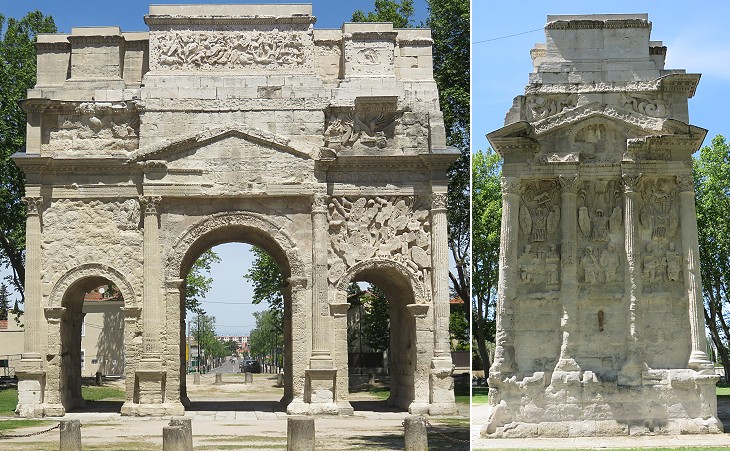
Triumphal Arch as it is today: (left) southern/town side; (right) eastern side
Orange was a post of consequence under the Romans, who called it
Colonia Secundanorum, and erected many
sumptuous edifices for the use and entertainment of its inhabitants: part of them are
still to be seen. The principal monuments
are, 1st. A triumphal arch of the Corinthian
order, now menacing ruin, the pillars that
have been built to support it being too weak
for the purpose.
Henry Swinburne - Travels through Spain in the Years 1775 and 1776 to which is added a Journey from Bayonne to Marseille - 1787 Edition
This town situated about 3 m E of the Rhone was the ancient Arausio and is remarkable for the interesting Roman remains which it possesses. The principal ones are 1. The Triumphal Arch situated about 1 m outside the town on the road to Valence. It is a handsome structure in a good if not in the best style of Roman architecture; its preservation is remarkable considering that it was incorporated in the palace of the Princes of Orange and the deep yellow tints of the stone, a tertiary limestone abounding in fossils of which it is composed, have a rich effect. (..) The building has been very judiciously repaired.
John Murray III - Hand-book for Travellers in France - 1843
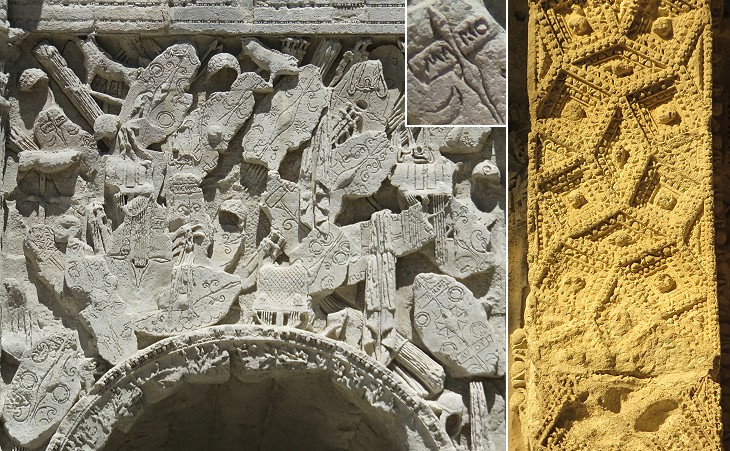
Triumphal Arch: (left) frieze above one of the side arches; (inset) MARIO; (right) decoration of the interior
The sunken panels in the vault of the central archway are very elegant. The bas reliefs with which it is adorned represent chiefly naval trophies (..) and a number of barbaric shields skilfully disposed; others consist of groups of figures but the subjects are not satisfactorily explained. (..) The date and destination of this arch are unknown; no inscription is visible excepting certain names inscribed on the shields among which the most distinct is MARIO and some have in consequence supposed that it was raised in commemoration of Marius' victory over the Cimbri near Aix. Murray
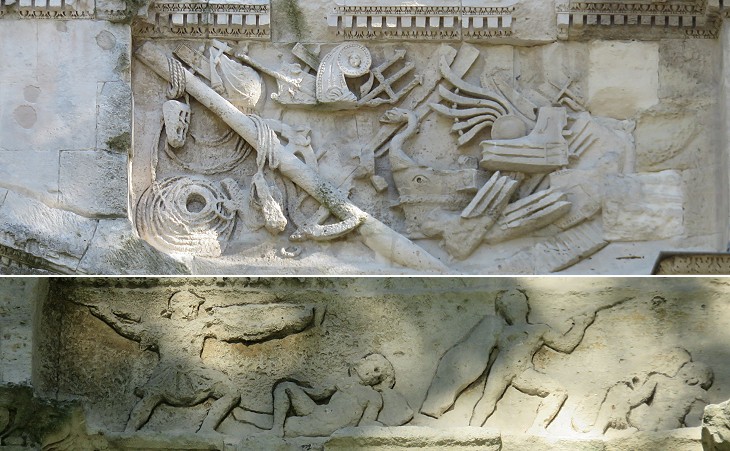
Friezes on the Triumphal Arch: (above) naval trophies; (below) battle between Romans and Gauls or Germans
It is decorated with trophies of various kinds, composed of masts, sails, and prows of gallies, shields, coats of mail, helmets, and weapons: on the shields are inscriptions not satisfactorily decyphered by the learned. (..) The antiquarians of the country insist that this monument was destined to commemorate the victory obtained by Caius Marius over the joint armies of the Cimbri and Teutones; (..) but there seems to be little reason for a trophy being erected at Orange on account of a victory gained near Aix; besides, the naval ornaments, and the tritons at the corners, point out a combat at sea, or upon the Rhone. (..) This arch is profusely covered with sculpture, but the workmanship is not delicate, nor the design agreeable; the style belongs to the age of Adrian and the Antonines. In that of Marius (..) architecture was in a rude state at Rome, and a monument erected by then would have been as plain and modest as this is overcharged with ornaments and ostentatious. Swinburne
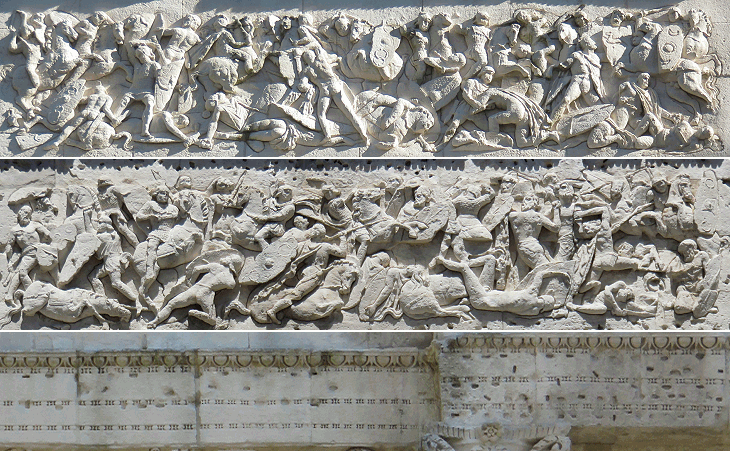
Triumphal Arch: (above) frieze at the top of the northern side (see a detail in the introductory page); (middle) similar frieze on the southern side; (below) holes which are evidence of bronze letters on the northern side
Today there is a general consensus that the purpose of the arch was to celebrate the deeds of Emperor Augustus and in particular his naval victory at Actium and the pacification of Gaul. A series of holes which were caused by the pulling out of nails supporting the bronze letters of an inscription have been studied at length (similar to what was done in Rome). The current opinion is that the inscription was a dedication to Emperor Tiberius in the year 27 AD and that it was added rather than being planned for in the design of the arch. Some archaeologists suggest that the two reliefs at the top of the arch depict victories over the Germans in 13-17 AD by Julius Caesar, the highly popular nephew and presuntive heir of Tiberius who is best known as Germanicus and who died in 19 AD in mysterious circumstances. In 41 AD his brother Claudius was proclaimed emperor.

Side of the arch; a detail of a relief at the top can be seen in the image used as background for this page
The overall decoration of the arch is indicative of who erected it, i.e. the Roman legionaries who were involved in the conquest of Gaul by Julius Caesar and eventually were rewarded by Augustus with a distribution of land which led to the foundation of Colonia Firma Iulia Secundanorum Arausio on the site of a previous Gallic settlement. Secundanorum is thought to be a reference to Legio II Gallica.
The war trophies on the sides of the arch are very similar to those which can be seen on Colonna Traiana. The boar was a standard of the Gauls.
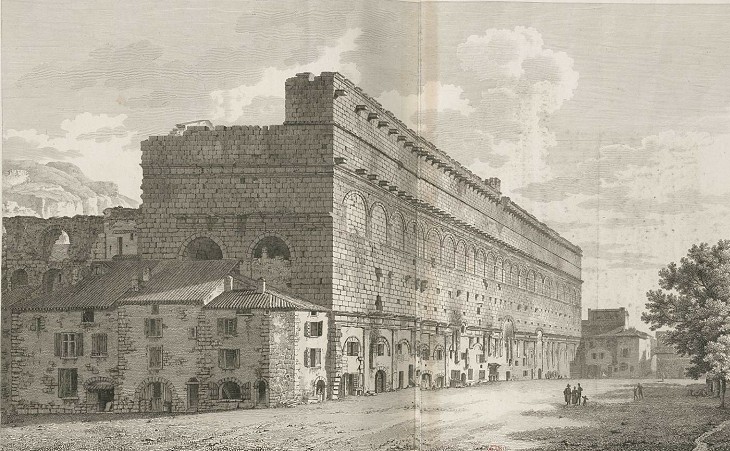
Rear wall of the Theatre in a plate from Laborde's book
There is also within the Citty a Cirque or an Amphitheater at the foote of the Rocke where on the Castle is
built, which is a place of very great antiquity, and built
by the Romans.
Francis Mortoft's Journal of his travels in France and Italy in 1659
The most remarkable monument of this city next to the triumphal arch is that which is improperly called the Circus. Coxe in Galignani's Traveller's Guide.
This lofty pile crosses a small oblong plain, even yet
unincumbered with buildings; it has all the
appearance of having been the stadium or
field, where the Circensian games were exhibited; many parts of the wall, such as
imperfect arches, interrupted cornices, and
toothings, indicate that there were galleries,
and seats affixed to it for the purpose of beholding the races and other entertainments.
The wall thus served a double purpose, and
while it backed the scena of the theatre, was
employed also in supporting scaffolds for the
shews of the Circus: it does not seem natural that this majestic ruin should have acquired the uncommon name of a circus, had
it never been any thing but a theatre, and
therefore I am of opinion that the name has
been handed down from the time of the
Romans by a regular tradition. Swinburne
Swinburne made an attempt to explain why the theatre was locally known as the circus and thus referred to by other English travellers.

Theatre: rear wall
Dating from the Augustean period, the
Theatre of Orange is one of the largest
Roman theatres known, and, moreover, the
best preserved, since the wall of the
façade (103 meters long by 37 meters high)
and that of the stage still exist in their
entirety, although deprived of their marble
facing.
From the description of the criteria utilized by UNESCO to include the Theatre of Orange in the World Heritage List in 1981.
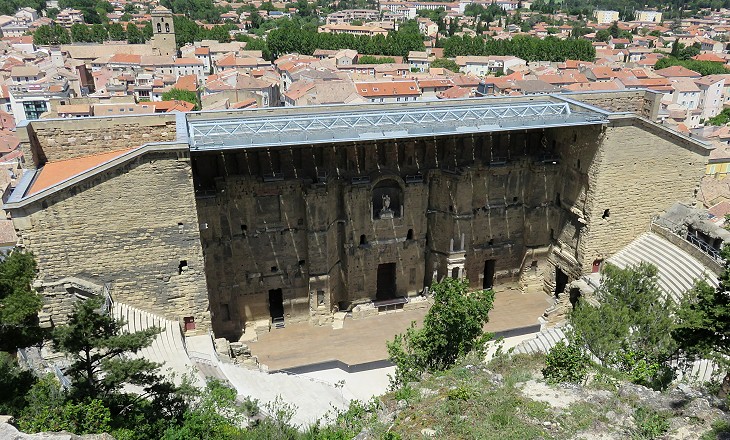
Theatre: interior seen from the top of the hill into which the seating section was partially excavated
This building conveys a better idea of an antique theatre, and explains more clearly its forms and distribution than any remains now extant; for
in all, except those of the theatre at Taormina, the scena is wanting. Here it is infinitely more perfect than in Sicily, and consists of two walls thirteen feet asunder; the
outermost is of the stupendous height of one
hundred and fifteen feet, being three hundred and thirty in length, covered in its
whole extent by a broad coping; the masonry is regular, and unimpaired. Below
the coping or cornice is a row of projecting
stones, bored through for the reception of
tent poles, to hold the awning over the spectators. (..) The company entered by
great gates on each side between the benches
and the towers; the actors and workmen were admitted through the center door, which
answered to a hall under the stage, and
through four smaller doors, that opened into
the lateral towers. Swinburne
The interior has recently been cleared of the miserable hovels which filled it and whose tenants in some instances burrowing like moles had formed cellars in the thickness of the walls regardless of the risk of undermining them and being buried in its ruins The removal of 100 of these cabins now enables the spectator to judge to a certain extent of the arrangement of the scene on its inner face. Murray
In the early XIXth century the Roman theatre of Orange was thought to be the only one which had retained its scenae frons, the high wall behind the stage which was decorated with columns and niches. In 1838 Charles Fellows reported that the theatre of Aspendos in Turkey also had its entire scenae frons and later on news came that the Castle of Bosra in Syria was actually the shell of a well preserved Roman theatre. These three specimens and in particular that of Bosra have been used by archaeologists for the reconstruction of the scenae frons of many other theatres, e.g. at Sabratha.
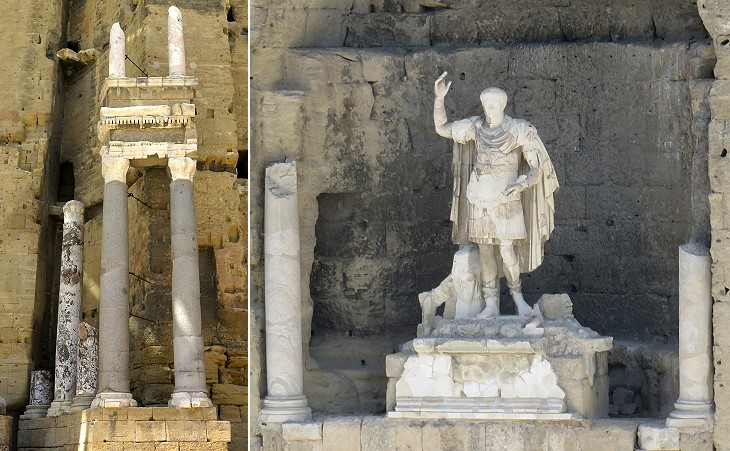
Theatre: details of the "scenae frons": (left) columns; (right) "Statue of Emperor Augustus" which was placed in a central niche in 1951 (the head is not original and the broken pieces of the statue which were found in the 1940s most likely portrayed an emperor or military commander of the IInd century AD)
The theatre was built at the time of Emperor Augustus and similar to that of Merida it was dedicated to him, although his statue might not have stood in the central niche. The construction of such a large entertainment facility in a recently founded town indicates that the veterans could rely on large financial resources. Augustus did not fail to mention in his spiritual testament what he spent for his veterans and for the establishment of colonies:
In the colonies of my soldiers, as consul for the fifth time, I gave one thousand sesterces to each man from the spoils of war; about one hundred and twenty thousand men in the colonies received this triumphal largesse. (..) To the municipal towns I paid money for the lands which I assigned to soldiers. (..) The sum which I paid for estates in Italy was about six hundred million sesterces, and the amount which I paid for lands in the provinces was about two hundred and sixty million. I was the first and only one to do this of all those who up to my time settled colonies of soldiers in Italy or in the provinces. And later (..) I paid cash gratuities to the soldiers whom I settled in their own towns at the expiration of their service, and for this purpose I expended four hundred million sesterces as an act of grace.
Res Gestae Divi Augusti - Loeb Edition
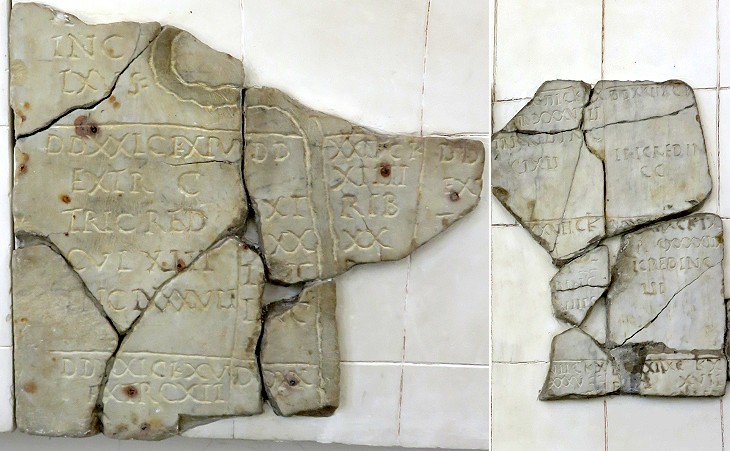
Museum of Orange: cadastral maps of the territory north of Orange
The distribution of land to the veterans was preceded by a survey of the ground (centuriatio) in order to identify the size and location of each individual farm and the need for roads and irrigation canals. The records of the survey were used for tax collection and legal proceedings. Each farm had a square shape which resulted in creating an orderly grid of fields which can still be noticed in the current landscape of some areas in Northern Italy. During the rule of Emperor Vespasian the centuriatio of Orange was updated and the results were carved in a marble map containing data on property and tax value. Each farm was identified with reference to a system of Cartesian coordinates with D(ecumani) as x and C(ardi) as y and its area was expressed in jugeri (0.25 hectares / 0.623 acres). The maps indicate that some farms no longer belonged to veterans (TRIC RED = returned to the Tricastins, the original Gallic inhabitants of the region) and some parcels of land were for public use.
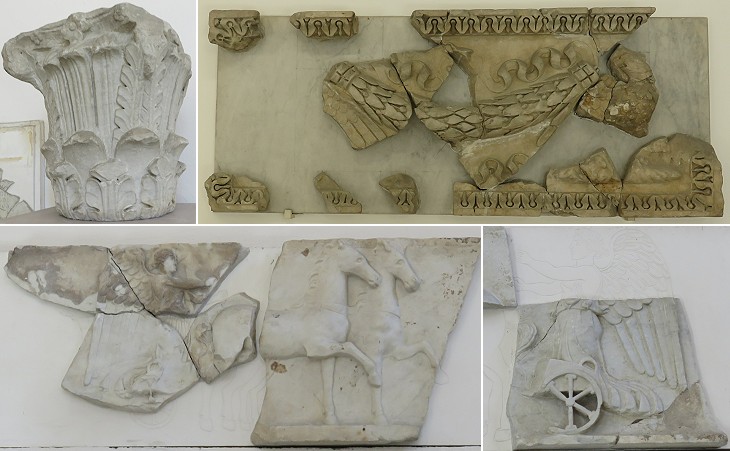
Museum of Orange: exhibits from the theatre
Theatres have often been a mine of archaeological findings because they were usually decorated with statues and reliefs. From this point of view the search for ancient works of art at the theatre of Orange was rather disappointing. The monument had not been covered by earth or rubble as many others and its marbles were most likely calcined or broken into pieces which were used as building material (see a page on Roman works of art related to theatrical performances).
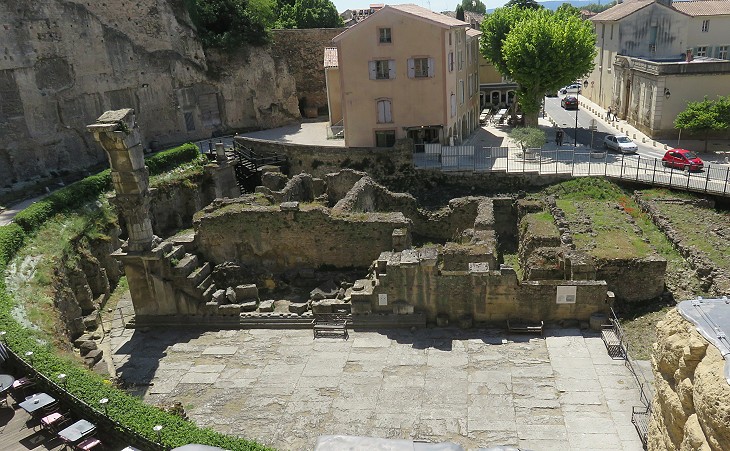
Remains of a temple at the side of the theatre
Side by side with this theatre ran a circus or hippodrome the greater part of which has disappeared quarried out to build the houses of the town except a few arches of the portico which joined it to the theatre. Murray
The ruins at the side of the theatre puzzled archaeologists for a long time. The semicircular area which contains them was thought to belong to a circus. Today the general opinion is that the area was one end of the Forum of the town and the ruins those of a temple. Other Roman monuments most likely stood at the top of the hill into which the theatre was partially excavated. They were incorporated into a fortress which was razed to the ground by King Louis XIV.
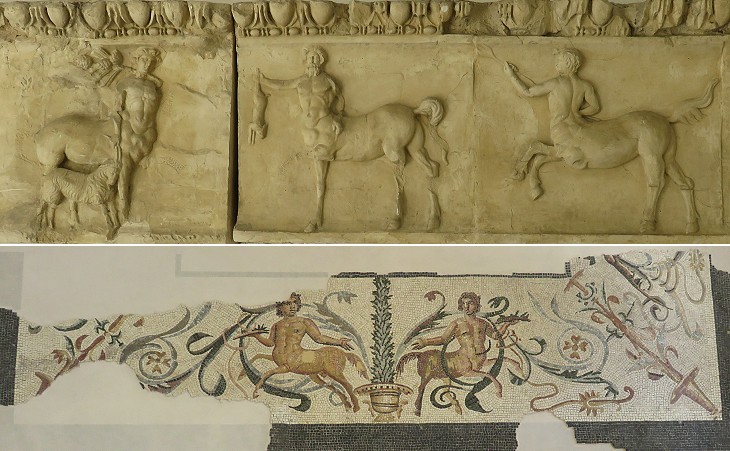
Museum of Orange: frieze (IInd century from the theatre) and mosaic (found in 1995 in the city centre) portraying centaurs
The Roman heritage of Orange is peculiar in the sense that it has two large monuments in a pretty good state of conservation, but almost nothing else. It is likely that the town was no longer a prosperous one during the IInd century AD, a period which elsewhere was characterized by the construction of grand monuments. We know that the individual small farms of the veterans at one point were unable to compete in the marketplace and their owners went bankrupt. Archaeological museums in many towns of Southern France have plenty of coloured floor mosaics, e.g. at Vienne, but this is not the case at Orange.

Museum of Orange: (left) funerary monument; (right) "Larva" (mask) of Polyphemus similar to masks at Lyon and Vaison-La-Romaine
What said for floor mosaics applies also to sarcophagi and other funerary works of art. A very interesting statue from a tomb which portrays a sphinx is dated approximately the same time as the Arch and the Theatre, thus confirming that Orange had his best period soon after its foundation. The sphinx and the skull would have been praised by XVIIth century Roman artists as a fine example of Memento Mori (Remember that You Will Die) sculpture. The sphinx was one of four which protected a tomb.
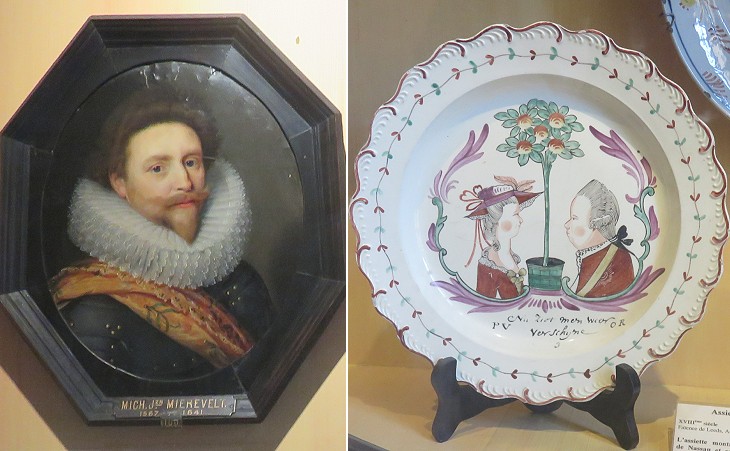
Museum of Orange: Princes of Nassau: (left) Philip William (1584-1618); (right) Leeds faience with a portrait of William III and his wife Mary at the sides of an orange tree (they became King and Queen of England, Scotland and Ireland in 1689)
The town, together with the principality, was devolved by marriage to the princes of the
house of Nassau, in whose possession it continued
for many years. Maurice prince of Orange made
it a regular fortress, but the town and principality were seized by Lewis XIV, in 1660, and the
fortifications entirely demolished. It was restored
to king William bv the treaty of Ryswick, but after
his death old Lewis seized it again, and expelled
the Protestant inhabitants. By the treaty of
Utrecht it was confirmed to the crown of France though the title is still retained by the house of
Nassau. (..) The principality is a very small
district, being twelve miles in length and nine in
breadth; the prince's revenue amounted to
about five thousand pounds per annum.
Thomas Nugent - The Grand Tour - 1749
The orange colour is still a symbol of the Netherlands.
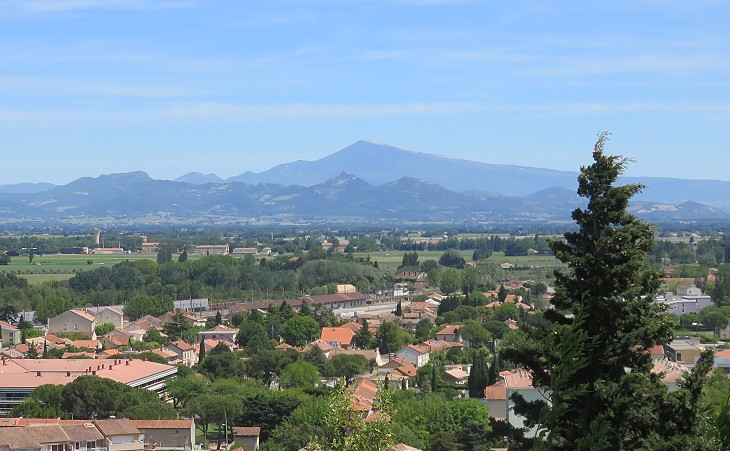
Mount Ventoux seen from the hill behind the Theatre
From this spot is a most delightful prospect of great extent and full of the most interesting objects. You behold the territory of Orange whose productions are so various, the plains of the ancient Comtat Venaissin; now the department of Vaucluse; a part of Provence and Languedoc with the mountains of Dauphiny and the noble stream of the Rhone. To the south the innumerable spires of the steeples of Avignon seem lost in the perspective while all around are the richest points of view; (..) Mont Ventoux and its hoary summit generally covered with snow and the handsome embattled walls of numerous towns. Amidst this delightful scenery the intelligent traveller looks with satisfaction on this classic ground where the Romans took delight in leaving so many monuments of their grandeur and power. The climate is heavenly, the soul is exalted, the eye is ravished, the imagination enchanted; you forget the world, you think you could remain here for ever! Coxe in Galignani's Traveller's Guide.
Ventoux means windy and this isolated mountain (1,909 m - 6,263 ft) is a landmark of the final section of the River Rhône valley.
Plan of this section:
Introductory page
Arles (Arelate)
Environs of Arles: Saint-Gilles, Aigues-Mortes and Saintes-Maries-de-la-Mer
Avignon (Avenio)
Carpentras (Carpentaracte), Cavaillon (Cabellio) and Pernes-les-Fontaines
Fontaine-de-Vaucluse and Le Thor
Glanum
Lyon (Lugdunum)
Marseille (Massilia)
Narbonne (Narbo Martius)
Nîmes (Nemausus)
Orange (Arausio)
Pont-du-Gard and Uzès
Saint-Bertrand-des-Comminges (Lugdunum Convenarum)
Tarascon (Tarasco)
Toulouse (Tolosa)
Vaison-la-Romaine (Vasio)
Vienne (Vienna)
Villeneuve-lez-Avignon

